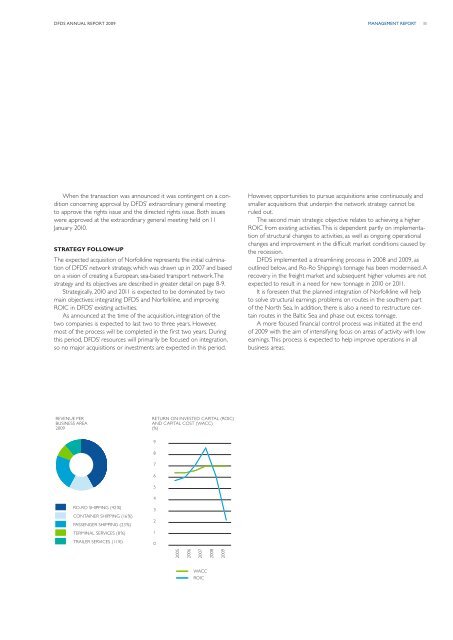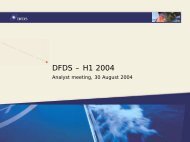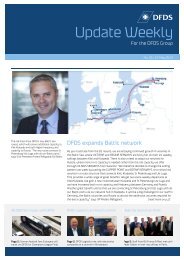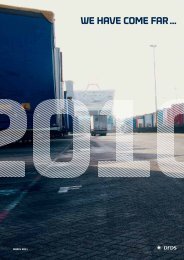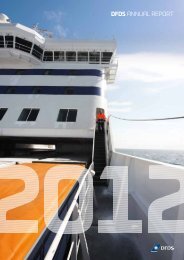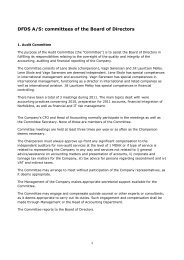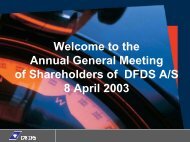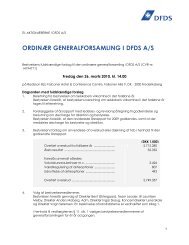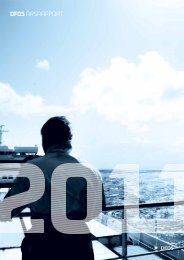English - DFDS
English - DFDS
English - DFDS
Create successful ePaper yourself
Turn your PDF publications into a flip-book with our unique Google optimized e-Paper software.
<strong>DFDS</strong> annual report 2009 Management Report 11<br />
When the transaction was announced it was contingent on a condition<br />
concerning approval by <strong>DFDS</strong>’ extraordinary general meeting<br />
to approve the rights issue and the directed rights issue. Both issues<br />
were approved at the extraordinary general meeting held on 11<br />
January 2010.<br />
Strategy follow-up<br />
The expected acquisition of Norfolkline represents the initial culmination<br />
of <strong>DFDS</strong>’ network strategy, which was drawn up in 2007 and based<br />
on a vision of creating a European, sea-based transport network. The<br />
strategy and its objectives are described in greater detail on page 8-9.<br />
Strategically, 2010 and 2011 is expected to be dominated by two<br />
main objectives: integrating <strong>DFDS</strong> and Norfolkline, and improving<br />
ROIC in <strong>DFDS</strong>’ existing activities.<br />
As announced at the time of the acquisition, integration of the<br />
two companies is expected to last two to three years. However,<br />
most of the process will be completed in the first two years. During<br />
this period, <strong>DFDS</strong>’ resources will primarily be focused on integration,<br />
so no major acquisitions or investments are expected in this period.<br />
However, opportunities to pursue acquisitions arise continuously, and<br />
smaller acquisitions that underpin the network strategy cannot be<br />
ruled out.<br />
The second main strategic objective relates to achieving a higher<br />
ROIC from existing activities. This is dependent partly on implementation<br />
of structural changes to activities, as well as ongoing operational<br />
changes and improvement in the difficult market conditions caused by<br />
the recession.<br />
<strong>DFDS</strong> implemented a streamlining process in 2008 and 2009, as<br />
outlined below, and Ro-Ro Shipping’s tonnage has been modernised. A<br />
recovery in the freight market and subsequent higher volumes are not<br />
expected to result in a need for new tonnage in 2010 or 2011.<br />
It is foreseen that the planned integration of Norfolkline will help<br />
to solve structural earnings problems on routes in the southern part<br />
of the North Sea. In addition, there is also a need to restructure certain<br />
routes in the Baltic Sea and phase out excess tonnage.<br />
A more focused financial control process was initiated at the end<br />
of 2009 with the aim of intensifying focus on areas of activity with low<br />
earnings. This process is expected to help improve operations in all<br />
business areas.<br />
REVENUE PER<br />
BUSINESS AREA<br />
2009<br />
RETURN ON INVESTED CAPITAL (ROIC)<br />
AND CAPITAL COST (WACC)<br />
(%)<br />
9<br />
8<br />
7<br />
6<br />
5<br />
4<br />
RO-RO SHIPPING (42 %)<br />
CONTAINER SHIPPING (16 %)<br />
PASSENGER SHIPPING (23 %)<br />
TERMINAL SERVICES (8 %)<br />
TRAILER SERVICES (11 %)<br />
3<br />
2<br />
1<br />
0<br />
2005<br />
2006<br />
2007<br />
2008<br />
2009<br />
WACC<br />
ROIC


